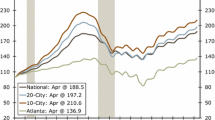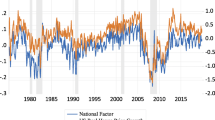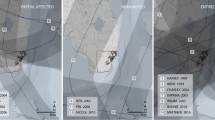Abstract
This study examines the effect of severe wind events on the mean and variance of housing price indices of six metropolitan statistical areas (MSA) that are vulnerable to hurricanes and/or tornadoes. The research focuses on three areas that experienced significant tornado activity (Fort Worth-Arlington, Nashville, and Oklahoma City) and three hurricane-prone areas (Corpus Christi, Miami, and Wilmington, NC). An econometric time series model that captures the housing market responses to severe windstorms is utilized. The model estimates changes in the local housing price index (HPI) as a function of several control variables as well as dichotomous variables that correspond to the tornadoes and hurricanes. As expected, the statistical findings indicate an immediate but short-lived decline in housing prices following a tornado or hurricane. Somewhat surprising is the result that the impact on the housing market is remarkably consistent whether the wind event was a hurricane or a tornado. Hurricanes and tornadoes are vastly different in terms of the point probabilities of a hit, the scope of the affected area and the lead time that supports last minute preparation to mitigate damage. It appears that the market response to destruction of real property does not distinguish between the types of wind event that produced the damage to the region. Results suggest that windstorms result in an immediate one-half to two percent reduction in total MSA housing value. This corresponds to a range of $34 million to $580 million in lost housing value. Estimates indicate some differences in how long market values continue to decline in the periods following the wind event; however, most of the decline occurs within four quarters after the windstorm. These differences can be attributed to the particular time series characteristics of the specific housing markets and their respective housing price indices. The market serves the purpose of integrating and normalizing the losses. In so doing the market provides a metric— a method for calibrating and comparing structural damage caused by different phenomenon.
Similar content being viewed by others
Notes
Refer to Section 5 for the definitions of parameters.
References
Bollerslev T, Chou RY, Kroner KF (1992) ARCH modeling in finance: A selective review of the theory and empirical evidence. J Econometrics 52:5–59
Calhoun CA (1996) OFHEO Housing Price Indexes: HPI Technical Description, http://www.ofheo.gov
Case KE, Shiller RJ (1989) The efficiency of the market for single-family homes. Am Econ Rev 79:125–137
Coulson NE, Richard C (1996) The dynamic impact of unseasonable weather on construction activity. Real Estate Econ 24:179–194
DeSilva DG, Kruse JB, Wang Y (2004) Catastrophe-induced destruction and reconstruction. Natural Hazards Rev 7(1):19–25
Diebold FX (2004) Elements of forecasting, 3rd edn. South-Western and Thompson Publication
DiPasquale D, Wheaton WC (1996) Urban economics and real estate markets. Prentice Hall
Ellson RW, Milliman JW, Roberts RB (1984) Measuring the regional economic effects of earthquakes and earthquake predictions. J Regional Sci 24(4):559–579
Enders W (2004) Applied econometric time series, 2nd edn. New York: John Wiley & Sons, Inc
Enders W, Sandler T, Cauley J (1990) Assessing the impact of terrorist-thwarting policies: an intervention time series approach. Defen Econ 2:1–18
Engle R (1982) Autoregressive conditional heteroskedasticity with estimates of the variance of the U. K. inflation. Econometrica 50:987–1008
Eves C (2002) The long-term impact of flooding on residential property values. Property Manage 20(4):214–227
Ewing BT, Covarrubias G (2003) Weather Shocks to Insurance Stock Prices, and Volatility Persistence. Proceedings of the 11th International Conference on Wind Engineering, Lubbock, Texas
Ewing BT, Kruse JB (2002) The impact of project impact on the Wilmington, North Carolina, labor market. Public Finance Rev 30(4):296–309
Ewing BT, Hein SE, Kruse JB (2003a) Insurer Stock Price Responses to Hurricane Floyd: An Event Study Analysis Using Storm Characteristics, Report to National Institute of Standards and Technology, U.S. Department of Commerce
Ewing BT, Kruse JB, Thompson MA (2003b) Labor Market Responses to Tornadoes. Proceedings of the 11th International Conference on Wind Engineering, Lubbock, Texas
Fergus JT (1999) Where, when, and by how much does abnormal weather affect housing construction? J Real Estate Finance Econ 18(1):63–87
Fronstin P, Holtmann AG (1994) The determinants of residential property damage caused by Hurricane Andrew. Southern Econ J 61:387–397
Graham JE, Hall WW (2002) Catastrophic risk and behavior of residential real estate market participants. Nat Hazards Rev 3(3):92–97
Guimaraes P, Hefner F, Woodward D (1993) Wealth and income effects of natural disasters: an econometric analysis of Hurricane Hugo. Rev Reg Stud 23(2):97–114
Gujarati DN (2003) Basic econometrics, 4th edn. New York: McGraw-Hill Publication
Hamilton JD (1994) Time series analysis. New Jersey: Princeton University Press
Harrison DM, Smersh GT, Schwartz AL Jr (2001) Environmental determinants of housing prices: the impact of flood zone status. J Real Estate Res 21(1/2):3–20
Harvey AC (1994) Time series models, 2nd edn. Cambridge, MA: MIT Press
Meade C, Abbott M (2003) Assessing Federal Research and Development for Hazard Loss Reduction. RAND Report, 39 pp
Murdoch JC, Singh H, Thayer M (1993) The impact of natural hazards on housing values: the Loma Prieta earthquake. J Am Real Estate Urb Econ Assoc 21(2):167–184
Risk Management Solutions (2004) Catastrophic Risk in the United States: Earthquake, Hurricane, Tornado and Hail. (Map) http://www.rms.com/Publications/Maps.asp#
Simmons K, Kruse JB (2000) Market value of mitigation and perceived risk: empirical results. Journal of Economics 26(1):41–51
Simmons K, Kruse JB, Smith D (2002) Valuing mitigation: real estate market response to hurricane loss reduction measures. Southern Econ J 68(3):660–671
Stewart MG, Rosowsky DV, Huang Z (2003) Hurricane risks and economic viability of strengthened construction. Natural Hazards Rev 40(1):12–19
Acknowledgements
This work was performed under the Department of Commerce NIST/TTU Cooperative Agreement Award 70NANB8H0059. We thank participants at the 2005 Southern Regional Science Association meeting (Arlington, VA) for useful comments and suggestions.
Author information
Authors and Affiliations
Corresponding author
Appendix
Appendix
With the pulse dummy specification, the coefficient of the dummy variable in the nth period determines the effect of a disaster for that period. In the following derivation, this study uses an ARMA(1,1) model for illustration purposes and assume one disaster in period t and no other disasters during the n periods after t.Footnote 1
In time period t:
If :
then,
And in period t + 1:
Substituting (2) into (3) gives:
Then in period t + 2,
Substituting gives:
So that in period t + n,
Therefore, the coefficient on the dummy variable in the nth period after the disaster is ψnδ and which measures the effect of the disaster on the local housing market in the nth period after the disaster.
Rights and permissions
About this article
Cite this article
Ewing, B.T., Kruse, J.B. & Wang, Y. Local housing price index analysis in wind-disaster-prone areas. Nat Hazards 40, 463–483 (2007). https://doi.org/10.1007/s11069-006-9005-1
Received:
Accepted:
Published:
Issue Date:
DOI: https://doi.org/10.1007/s11069-006-9005-1




